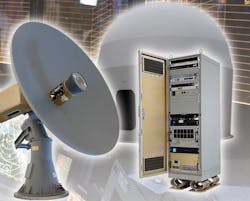Navy makes $10.3 million order to Harris to provide SATCOM aboard big surface warships
Officials of the Space and Naval Warfare Systems Command (SPAWAR) in San Diego, are asking Harris Corp. in Melbourne, Fla., to provide Commercial Broadband Satellite Program (CBSP) Force Level Variant (FLV) SATCOM equipment under terms of a $10.3 million contract modification.
The new order include two CBSP FLV dynamic shipboard systems, three CBSP FLV dual-antenna and dual-channel systems, and one CBSP FLV dynamic shipboard system with radar cross section reduction. The Harris CBSP FLV SATCOM gear is for aircraft carriers, amphibious assault ships, and other large-deck Navy surface ships.
The CBSP FLV provides the Navy with terminal-to-shore, space, and terrestrial connectivity to increase data throughput of data; improve SATCOM reliability; and provide SATCOM redundancy.
Related: Raytheon to provide next-gen Navy shipboard SATCOM in potential half-billion-dollar deal
The Harris CBSP FLV SATCOM equipment involves 8.9-foot terminals with C- and Ku-band capabilities. The equipment's relatively high bandwidth capacity enables Navy communications experts to provide high-speed Internet access for as many as 5,000 military personnel onboard each surface warship.
The new terminals are replacing existing Harris AN/WSC-8 C-band SATCOM terminals. CBSP FLV terminals 21.6 to 51.8 megabits per second of data throughput using single channel per carrier (SCPC) modems and dynamic bandwidth modems.
On large ships, the terminal can be configured with dual antennas to minimize the effects of superstructure blockage. The system uses a single dual-band feed that supports simultaneous C and Ku-band operations.
The CBSP FLV terminal supports missions like quality-of-life and super-high-frequency (SHF) military SATCOM backup. It provides ship crews with email, Web browsing, chat rooms, file transfers, voice over IP telephone service.
Related: Navy orders shipboard radios from General Dynamics for surface warships and submarines
This equipment also provides access to military NIPRNET and SIPRNET data, secure telephones, afloat personal telecommunication, video teleconferencing, telemedicine and medical imagery, national primary image dissemination, and intelligence database and tactical imagery.
The antennas provide IESS-601 standard G compliant beam patterns using a 2.74-meter reflector mounted on a high dynamics three-axis pedestal enclosed within a protective radome. The pedestal provides continuous azimuth axis rotation and incorporates inertial elements for stabilization.
The below deck communications equipment is housed in an RFI-shielded cabinet with modems, antenna control unit, and supporting equipment with cables. The terminal contains two different types of modems -- the MD-1366 Enhanced Bandwidth Efficient Modem (EBEM) for static SCPC operation, and the SLM-5650 dSCPC modem for dynamic operation.
On this contract modification Harris will do the work in Melbourne, Fla., and should be finished by January 2017. For more information contact Harris Corp. online at http://harris.com, or SPAWAR at www.spawar.navy.mil.

